Teeth
Keep tooth in mouth
Unusual, but possibly useful, dental advice: If a tooth gets knocked out, put it back in your mouth, between your cheek and gum. This will help to keep the tooth alive. And if you can then get to a dental surgeon within 90 minutes, it might be possible to replant the tooth.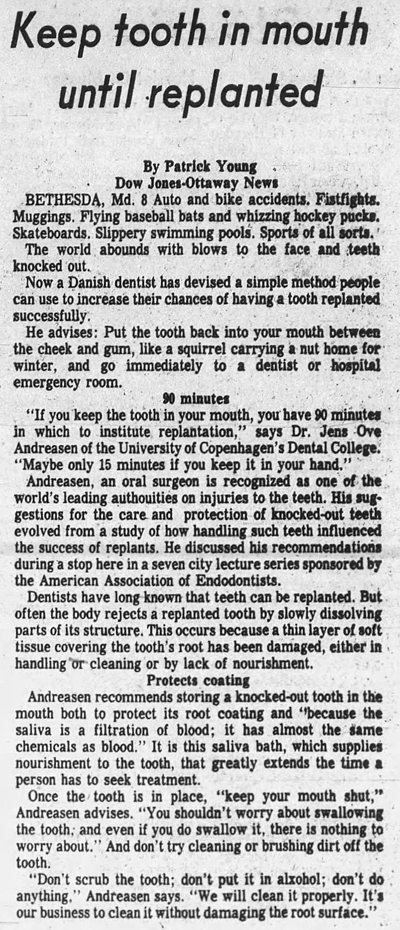
Sunbury Daily Item - Jun 5, 1976
Posted By: Alex - Mon Feb 28, 2022 -
Comments (3)
Category: Teeth
Toothache-Killer Cigarettes

Los Angeles Times - Aug 12, 1991
A search of the patent records turned up a 1994 Chinese patent (CN1106283A) for these 'toothache-killer cigarettes':
I wonder what happens if you smoke them when you don't have a toothache. Would your mouth go numb?
Posted By: Alex - Wed Jan 26, 2022 -
Comments (3)
Category: Patents, Smoking and Tobacco, Teeth
The Gnathograph
The Gnathograph, or 'dental articulator', was the invention of Los Angeles dental surgeon Beverly McCollum. He was also the founder, in 1926, of the Gnathologic Society.The name 'Gnathograph' derived from 'gnathology,' this being the study of the jaw and masticatory system, from the greek word 'gnathos' meaning 'jaw'.

"The formidable contraption shown in the mouth of Miss Pearl Nord is a gnathograph, invented by Dr. Beverly B. McCollum of Los Angeles and demonstrated before the chicago Dental Society. It records direction of bite and fit of teeth and accurately guides a dentist in straightening crooked teeth or fitting inlays, crowns, bridges and plates."
image source: Agi Haines

The band Femur used the image above from Popular Science as the cover art for their album Red Marks.

Posted By: Alex - Sun Oct 03, 2021 -
Comments (0)
Category: Inventions, Patents, 1930s, Teeth
Follies of the Madmen #509
Was this ever such a drastic problem, or one of those made-up Madison Avenue problems?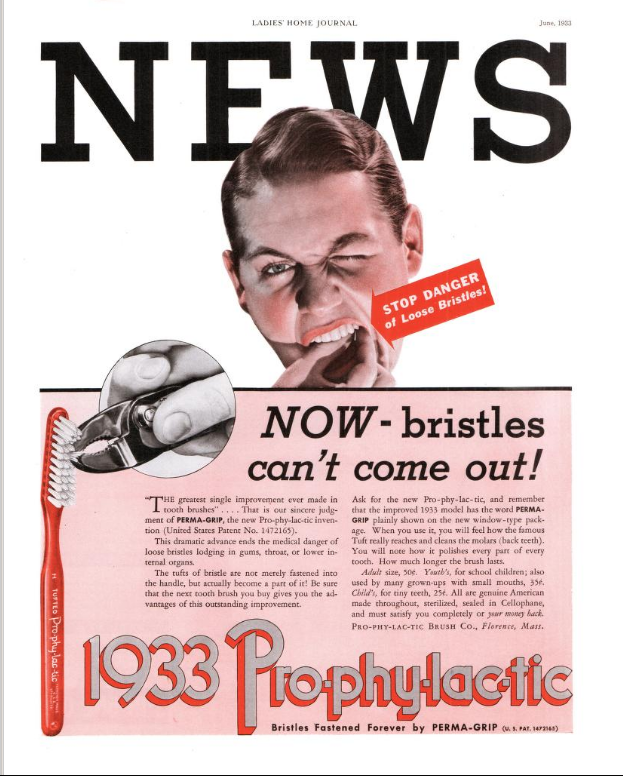
Posted By: Paul - Tue Jun 15, 2021 -
Comments (4)
Category: Business, Advertising, Hygiene, 1930s, Teeth
Yu Qian’s Tower of Teeth
We've previously posted about the Tooth Stone of Elkhart, Indiana, which is a large, concrete block full of human teeth.Along similar lines is the Tooth Tower of Yu Qian in Beijing. It's a large sculpture made out of 28,000 human teeth.
If I come across any more sculptures made out of human teeth, I'll be sure to add them to this list.

Elko Daily Free Press - July 28, 1995

Posted By: Alex - Thu Apr 22, 2021 -
Comments (2)
Category: Art, Teeth
Follies of the Madmen #496
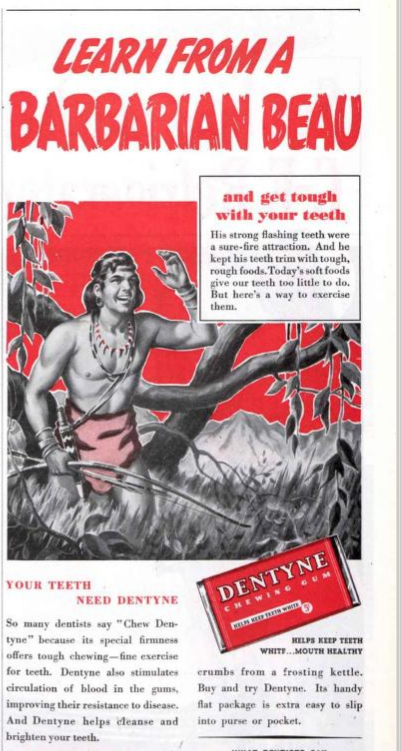
Tarzan chews Dentyne.
Posted By: Paul - Sun Jan 03, 2021 -
Comments (1)
Category: Business, Advertising, Foreign Customs, 1940s, Teeth
The Poet Laureate of Dentistry
Note: after preparing this post, I realized that Paul had posted about the same thing two years ago. So consider this a repost.Soylman Brown (1790-1876) was a Connecticut dentist who achieved prominence in his profession for a number of reasons. According to Wikipedia, he founded the first dental school, the first national dental society, and the first US dental journal. Plus, he became known as the Poet Laureate of Dentistry on account of his fifty-four page poem titled Dentologia - A Poem on Diseases of the Teeth, and Their Proper Remedies. It was published in 1840.

If you've got some time to kill, you can read the entire poem at the Internet Archive. Otherwise, I've sampled a brief part of it below, which should be enough to give you its general tone.
For oft, obstructed nature, laboring there,
Demands assistance of experienced art,
And seeks from science her appointed part.
Perhaps ere yet the infant tongue can tell
The seat of anguish that it knows too well,
Some struggling tooth, just bursting into day,
Obtuse and vigorous, urges on its way,
While inflammation, pain, and bitter cries,
And flooding tears, in sad succession rise.
The lancet, then, alone can give relief,
And mitigate the helpless sufferer's grief;
But no unpractised hand should guide the steel
Whose polished point must carry wo or weal:—
With nicest skill the dentist's hand can touch,
And neither wound too little nor too much.
Posted By: Alex - Sun Nov 22, 2020 -
Comments (0)
Category: Poetry, Nineteenth Century, Teeth
Remove the braces, or else…
I'm sure this must have been the strangest day in Norman Carstens' career as an orthodontist:"I had him in the chair and he leaned over and pulled the gun out of his pocket and said, 'Would this make you change your mind?' and I said, 'Yes,'" Carstens said.
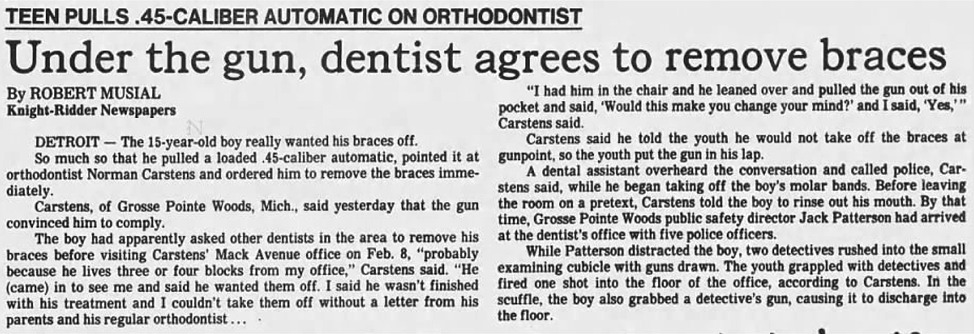
(click to enlarge)
Central New Jersey Home News - Feb 16, 1985
Posted By: Alex - Thu Sep 10, 2020 -
Comments (0)
Category: 1980s, Weapons, Teeth
Keep the mouth glands active
"unless we watch out, the mouth glands slow up and decay sets in. The formula to correct this was worked out in Pebeco Tooth Paste."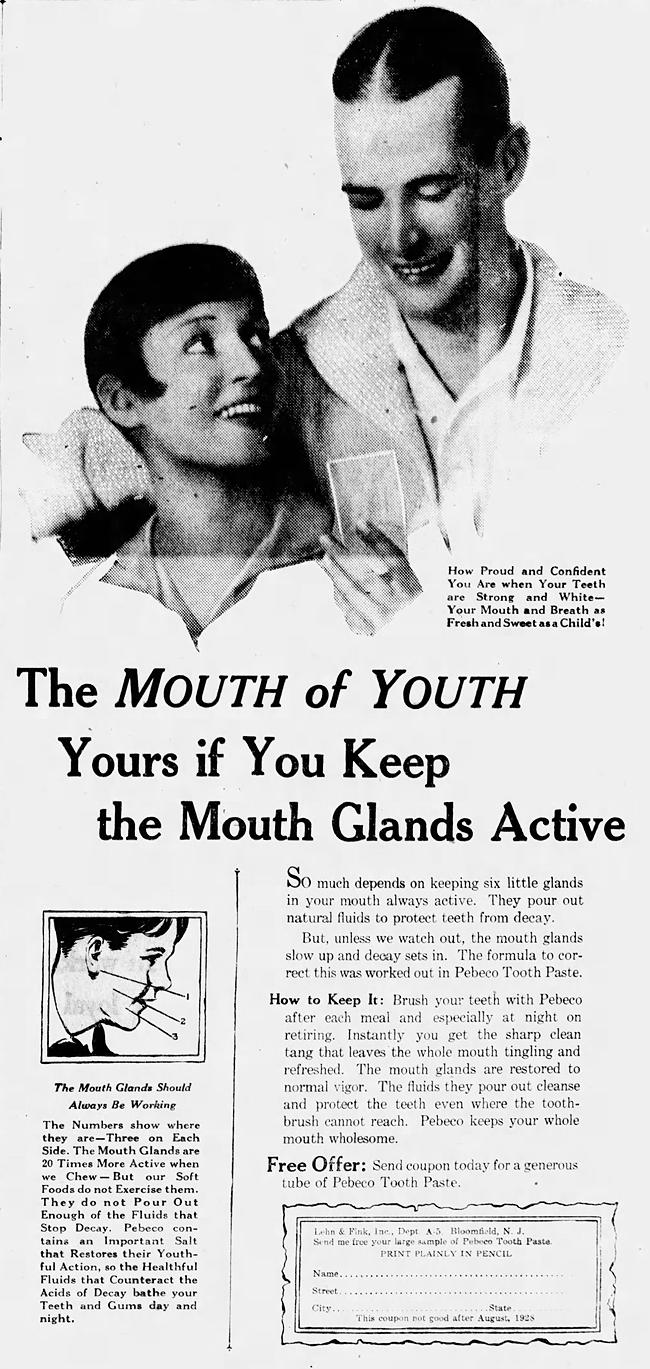
San Francisco Examiner - Aug 21, 1927
Posted By: Alex - Mon Aug 24, 2020 -
Comments (1)
Category: Hygiene, Advertising, 1920s, Teeth

| Who We Are |
|---|
| Alex Boese Alex is the creator and curator of the Museum of Hoaxes. He's also the author of various weird, non-fiction, science-themed books such as Elephants on Acid and Psychedelic Apes. Paul Di Filippo Paul has been paid to put weird ideas into fictional form for over thirty years, in his career as a noted science fiction writer. He has recently begun blogging on many curious topics with three fellow writers at The Inferior 4+1. Contact Us |






